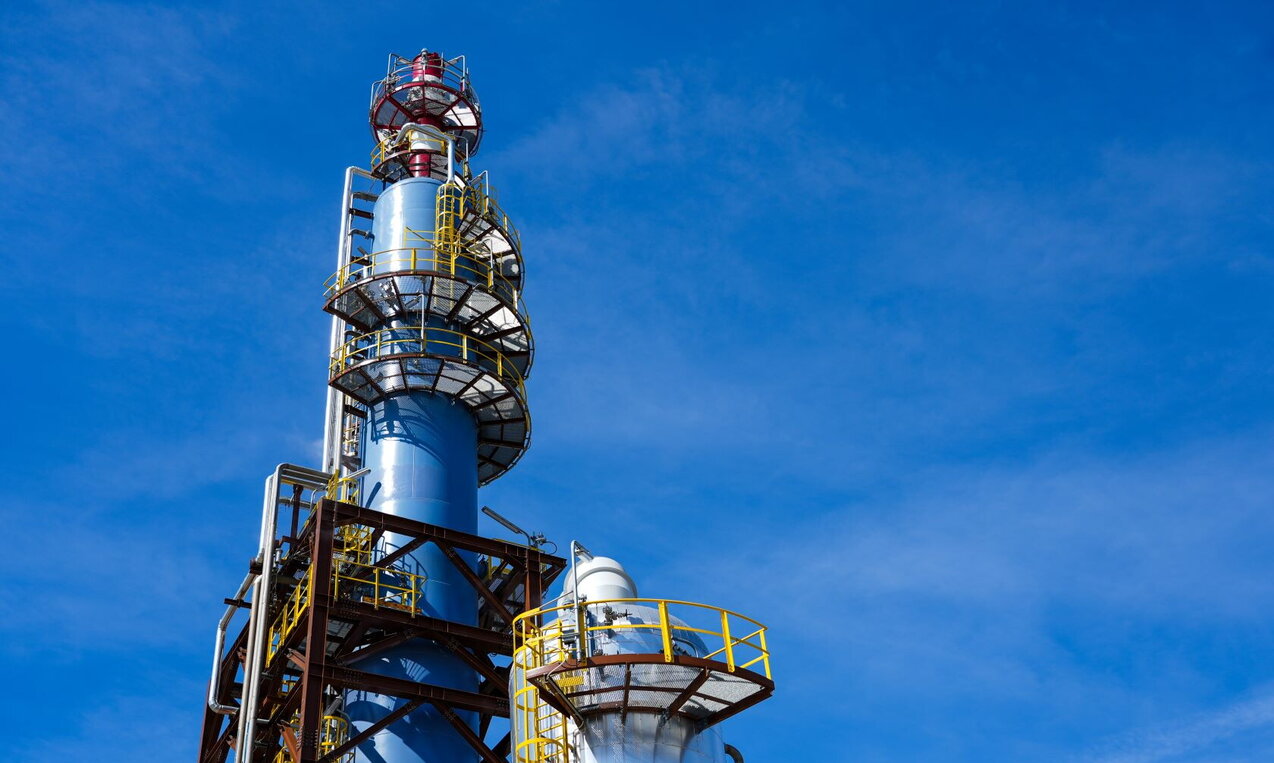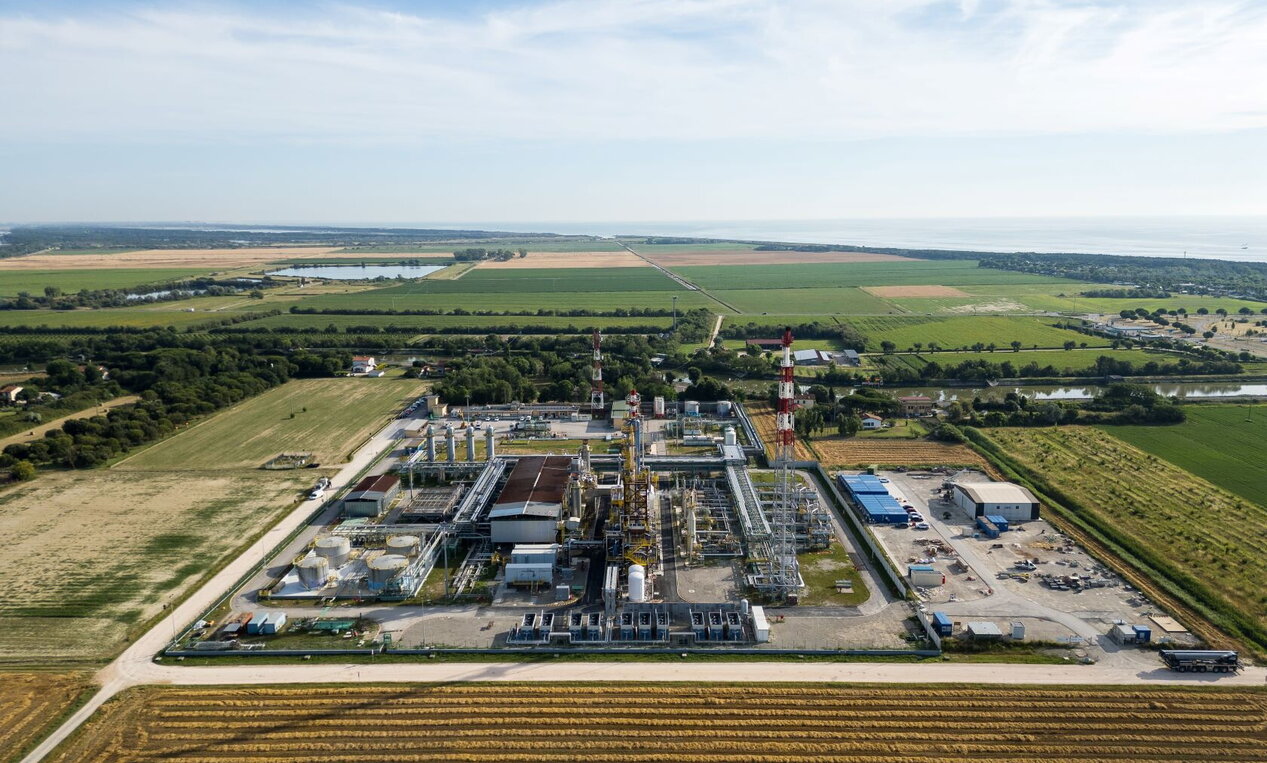
The key word is transition
The Eni model
Carbon capture and storage technology is one of the key levers of Eni’s strategy toward carbon neutrality, aiming for long-term storage capacity of more than 60 million tons of CO2 per year. The Ravenna CCS and HyNet projects
14 minC
arbon dioxide (CO2) is a naturally occurring gas in our atmosphere. It’s non-flammable, non-explosive, and plays a vital role in various natural processes. One of the advanced techniques to address climate change is CO2 capture and storage (CCS). The concept of capturing CO2 and injecting it deep underground for permanent storage is not new. In fact, the oil industry has been using a similar method called “Enhanced Oil Recovery with CO2” for decades. This process involves injecting CO2 into oil fields to make it easier to extract leftover oil, thereby improving production.
Recently, this technology has gained attention for its environmental benefits. By capturing carbon dioxide emissions from industrial sources and storing them in geological formations, CCS offers a promising way to reduce greenhouse gas emissions. This method can significantly mitigate the impact of climate change, making it a viable and competitive solution for a sustainable future. During the capture stage, carbon dioxide is extracted directly from the chimneys of industrial plants and separated from other gases. Once captured, the purified CO2 is compressed to facilitate transport via pipeline, sea, or road. It is then permanently stored in deep geological formations, such as depleted gas fields or saline aquifers, following thorough geological and technical analyses to verify the suitability of the underground formations for permanent storage.
Effective and available technology
CO2 removal through CCS represents a concrete solution for the decarbonization of hard-to-abate sectors such as cement, chemicals, steel, glass, and others. For these industries, it is the only effective and efficient technology available today, both in terms of the volume of CO2 it can handle and its cost and timing.
In addition to its role in decarbonizing industrial sectors, CCS is pivotal in maintaining balanced electrical grids. The inherent intermittency and non-dispatchability of renewable energy sources, which fluctuate daily and seasonally, pose significant challenges. CCS can effectively address these challenges by preserving a portion of decarbonized and dispatchable energy production from natural gas, thereby minimizing the carbon footprint of this dispatchable energy

Looking ahead, Carbon Dioxide Removal technologies, such as Bio-Energy with Carbon Capture and Storage (BECCS) and Direct Air Capture (DAC or DACCS), are poised to play crucial roles. Both technologies involve transporting and storing carbon dioxide through CCS, but the CO2 they capture differs in origin. DAC captures CO2 directly from the atmosphere, while BECCS captures CO2 emitted from the industrial or energy use of biomass, which absorbs carbon from the air through photosynthesis during its growth. Both approaches can achieve a net reduction in atmospheric CO2 levels, helping to decrease the accumulated carbon dioxide from the past. Therefore, these technologies are considered carbon negative.
The importance of CCS in achieving the zero-emission goal has been emphasized by the European Union, the United Nations, the United States, and major international organizations such as the International Energy Agency (IEA), the Intergovernmental Panel on Climate Change (IPCC), and the International Renewable Energy Agency (IRENA).
In the decarbonization scenarios they have put forward, CCS plays a significant role, contributing between 8 and 22 percent of the total cumulative 2020-2050 emissions abatement from various decarbonization strategies. By 2050, this corresponds to about 6-7 billion tons of CO2 captured and stored per year (GTPA).
Eni’s strategy
In 2023, the strategic study “Zero Carbon Technology Roadmap - Carbon Capture and Storage: A Strategic Lever for the Decarbonization and Competitiveness of Italy,” presented by The European House-Ambrosetti in collaboration with Eni and SNAM, highlighted how CCS fits into a technology-neutral approach. This approach is essential for achieving decarbonization targets at both European and national levels. At Eni, we strongly believe in the importance of CCS and have included it among the key levers of our decarbonization strategy. We have set a goal of achieving a gross annual injection capacity of more than 15 million tons per year by 2030, with plans to progressively increase this capacity to around 40 million tons per year after 2030 and exceed 60 million tons per year in the long term.
To achieve this, we have established a distinguished model based on the availability of existing upstream assets, such as depleted gas reservoirs. We are leveraging our extensive knowledge of geological structures and our historical expertise in the underground storage of strategic natural gas reserves. We intend to use our expertise to repurpose existing assets into carbon dioxide storage hubs, aiming to decarbonize both our own and third-party industrial activities at competitive costs and with an accelerated time to market. By leveraging the proximity of these storage hubs to industrial clusters, we are in a privileged position to implement Transportation and Storage (T&S) projects efficiently.

Ravenna CCS
Ravenna CCS is the first project in Italy embodying our model. Developed jointly with SNAM, it will utilize Eni’s offshore depleted gas reservoirs in the Adriatic Sea and related existing infrastructure, with an overall total storage capacity estimated to exceed 500 million tons. With a potential injection capacity of up to 16 million tons per year, the project will follow a phased approach to expedite the start of CO2 permanent storage. This phased strategy will allow the project to grow in tandem with third-party industrial CO2 capture initiatives.
Phase 1 of the project is scheduled to start by July 2024, with an initial injection of 25,000 tons per year of CO2. This CO2 will be captured from Eni’s Casalborsetti gas power plant and injected into the depleted reservoir of the Porto Corsini Mare West (PCMW) field. In parallel, we are advancing the engineering studies for Phase 2, which will involve storing CO2 in both the aforementioned PCMW reservoir and the Garibaldi-Agostino (PGA) reservoir, which is currently being depleted. During this phase, the CO2 injection storage rate will ramp up to 4 million tons per year by 2030. Ravenna CCS will store emissions from our own assets and provide transportation and storage services for third-party hard-to-abate industrial activities in Italy and Europe. The project is expected to become the CCS hub of reference for emitters in Italy and the Mediterranean area, and one of the world’s largest CO2 storage sites.
Moreover, we go beyond being a simple provider of T&S services by assuming the role of “orchestrator” of large-scale CCS Hub projects. Eni’s proven competence in managing complex projects, a heritage of our long-standing upstream experience, allows us to provide a complete set of services to emitters along the full value chain. Through an “end-to-end” approach, we cover the entire lifecycle of a project. We will support emitters with the selection and coordination of optimal capture solutions for both onshore and offshore transportation, including shipping services for those emitters beyond the reach of pipeline transportation.
HyNet NorthWest
In this regard, we have become the lead company in the consortium delivering the HyNet NorthWest project in the Liverpool Bay area (LBA), further strengthening our role as operators in carbon capture and storage in the United Kingdom. The project aims to transform one of the most energy-intensive districts in the UK into its first low greenhouse gas emission manufacturing district. The project involves injecting CO2 into three offshore depleted fields in Liverpool Bay (Hamilton, Hamilton North, and Lennox) with an initial storage capacity of 4.5 million tons per year, which will be increased to 10 million tons per year in the early 2030s. The startup of the entire cluster is expected before 2030, consistent with the schedule of the five selected emitters. In addition, we have launched the new Bacton Thames Net Zero initiative in the southern North Sea of the United Kingdom, which will develop a CCS project to contribute to the decarbonization of the Bacton area and the Thames estuary. These initiatives position the UK as a leading candidate to become the primary CCS platform of reference for supporting the decarbonization of European industry.
We have established a leadership position, particularly in the UK and Italy, and are further expanding in North Africa and Europe with projects related to both hard-to-abate sectors and the upstream industry, strengthening our commitment to supporting the decarbonization journey. Our unrisked portfolio of opportunities amounts to approximately 3 gigatons of gross storage capacity. Through the recent Neptune acquisition, we have obtained storage licenses in the Netherlands and the UK, with ongoing studies in Norway. In addition to mitigating hard-to-abate emissions, CCS can be integrated with upstream projects, such as those in Libya and the UAE, to reduce Scope 1 and 2 emissions from oil and gas production fields.
The challenges: costs and the regulatory framework
CCS projects also present some difficulties and challenges, above all costs and the regulatory framework. The centrality of climate urgency on the international political agenda has generated strong and growing interest in CCS and more in general to “Carbon Capture Utilization and Storage” (CCUS). Major international organizations recognize CCUS as a crucial element in the energy transition, including it among the necessary solutions to achieve carbon neutrality by 2050. However, the announced CCUS projects fall significantly short of the anticipated growth rate in all scenarios, with the projected capacity for 2030 being 3-4 times greater than what has been announced to date.

Additional support mechanisms for emitters can also provide the momentum needed to kickstart the CCS market. Carbon contracts for difference, for example, can reduce the financial risk of investments in carbon capture technology, thereby lowering the barrier to larger deployments of this decarbonization solution. CCS costs are expected to fall rapidly as the industry grows and more competitors enter this emerging market. Capture costs are already substantially lower than earlier estimates, reflecting the progress made with the development of actual facilities in recent years. By adopting our approach, centered on CCS hubs that reuse existing facilities, we can offer highly competitive costs, positioning ourselves in the lower range of current estimates.
Decision makers will play a crucial role in contributing to cost decreases by defining clear and straightforward regulatory frameworks, fostering standardization and international cooperation, and supporting the development of national and international infrastructures that match capture demand with storage supply. Public support and a clear CCS strategy will also boost investor interest in this market, leading to decreased financial costs. The development of CCS industrial hubs and a CO2 market will be crucial. These hubs will allow for economies of scale in the transport and storage segments, enabling multiple players to share infrastructure development. This approach will result in lower unit costs, reduced risk, and greater standardization.
For Eni, CCS represents an opportunity not only to reduce our net emissions but also to generate value. By providing a decarbonization solution for third-party hard-to-abate emitters beyond the energy sector, we create a new transition-linked business. This approach will allow us to apply our distinctive satellite model to support further investments, thereby maximizing value creation and returns for Eni.
CCS represents one of the key levers in Eni’s strategy toward carbon neutrality. This strategy is articulated in a solid and concrete industrial transformation plan focused on the use of multiple technological solutions that are already available at the industrial level or can be implemented in the short term.

